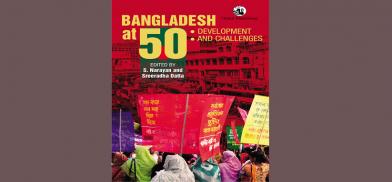Bangladesh at 50: Development and Challenges
Bangladesh at 50: Development and Challenges. Edited by S Narayan and Sreeradha Datta. Publisher: Orient Black Swan. Pages 263.

Bangladesh will be 50 years old in 2021, and the last 50 years has been a remarkable journey for that country. It had been given up as destined to remain in poverty, and yet, over the last five decades has demonstrated an ability to grow and develop that has outpaced its South Asian neighbours ( including India), on several parameters. It is today one of the fastest developing countries in Asia, and is transitioning to a middle-income country. Interestingly, there is not much written about the development story of this country, apart from multilateral agency reports.
There are different facets to this story. At one end, there has been considerable political turmoil, and it is only in the last decade that there is a continuity in governance, with the opposition driven to disarray. There has also been a growth of fundamental Islam, especially since the eighties, when Saudi influence was palpable in the development of madrassas and mosques, in the wake of the oil boom. There have been challenges in foreign policy, with the ruling Awami League and the opposition Bangladesh Nationalist Party (BNP) and the ideologies taking quite different views about engagements with India. There has also been a considerable rise in income inequalities. Women’s role in society and institutions remains a concern, as is rising militancy.
Notwithstanding these, there has been remarkable progress in many areas of economic development. Fertility rates have dropped from close to 6 in 1971 to almost 1.9 in 2005. Female literacy, rural sanitation, drinking water supply coverage and other basic parameters are close to, and in cases exceeding, those in India. In ready-made garment exports, it is second only to China, and far ahead of India. Inward remittances from overseas workers are high, and together with garment exports, have kept the currency steady. There has been a steady six percent or above growth, consistently, over the last decade. It is a story of unexpected success.
Drs S.Narayan and Sreeradha Datta reached out to eminent scholars and intellectuals in Bangladesh and at the Institute of South Asian Studies (ISAS), National University of Singapore, to put together an edited volume "Bangladesh at 50: Development and Challenges", that attempts to chronicle the development journey, and to examine just how exactly Bangladesh could achieve such success. The book also identifies challenges in the political and religious environment, that could slow down the development, and sectors where it could do better.
Mustafizzur Rahman of the Center of Policy Research, Dhaka writes about the parameters of development and the policies that enabled this development to take place. Salim Rehan and Amitendu Palit have contributed two chapters dealing with the success of the ready-made garments sector, how this came about, and the challenges that lie ahead. S.Narayan examines the role of multilateral agencies and NGOs, trying to examine the causes of success. The monetary policies that have stood by this development story are chronicled by Salehuddin Ahmed.
The chapters that follow outline some of the concerns. Sreeradha Datta examines the contemporary politico-social fabric, while Amena Mohsin looks at the empowerment of women in the Bangladesh context. Amit Ranjan writes anxiously about growing evidence of militancy and S.Narayan about concerns arising out of rising energy demand.
Bangladesh-India relations are discussed by Shamsher Chowdhury, former Bangladesh foreign secretary, while Sreeradha Datta also examine the narrative of foreign policy development.
This is an attempt by ISAS to bring together scholars and policy makers from Bangladesh and India to talk about the development of Bangladesh - a collaborative effort from both countries. There has not been an attempt at similar collaboration for several years now.
The interesting point that the editors make is that to a great extent the successes in the development story are due to the space that was given to multilateral agencies, NGOs, and the private sector to operate. After 1971, when institutional structures were weak, the government allowed NGOs like Grameen Bank and BRAC free play. They also allowed the population programme to be managed and controlled by multilateral agencies. The garment story is a story of government ceding space to the private sector in the industrial development policy sphere.
It is possible to argue that the weakness of government institutions enabled alternate development models to emerge and succeed. Such a situation is very different from India, where, from the very beginning, the government was clear on its approaches to development, and set up institutions in support.
The results of the alternative approaches are there to see and are an interesting study for policy makers and policy watchers in other countries, particularly South Asia.










Post a Comment